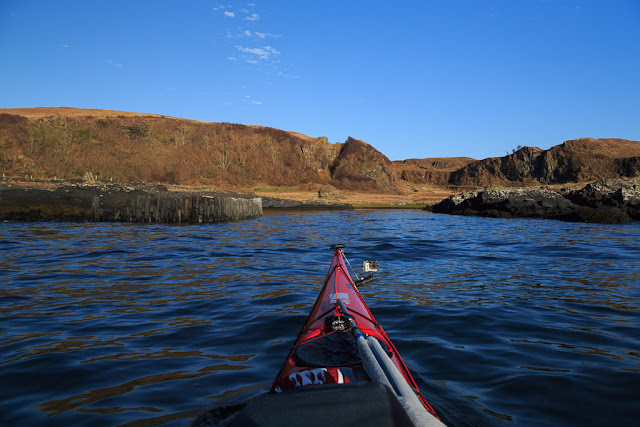...West Loch Tarbert in the west and Tarbert Bay in the east. The connecting isthmus is only 1.9km wide and 26m high. I had last portaged across here in 2007 but since then increasing knee dislocations a nasty accident to my knee, major operations to both knees and shoulder surgery and a few other health problems had prevented a return. However it was now payback time for the countless hours of physiotherapy. I was very much looking forward to returning to old haunts on Jura and Islay. The best places to read about Islay (and Jura) are Armin Grewe's IslayBlog.com and Ron's Islay Blog.
The first part of the beach was hard firm sand and proved easy enough then you come to a deep layer of rotten sea weed at the high tide mark which is hard going. Fortunately it was not as extensive as on previous visits. From the top of the beach to the track to the wooden cabins is the worst bit. If you were on your own you might need to unload to get across this bit.
The two of us managed fine and after a short time we were on what passes as the main road on Jura. We saw no vehicles and no people but...
...udder, though I can't imagine why. However, neither Old Norse origin really stands up to close scrutiny. Ecclesiastical writing in AD678 recorded what we now know as Jura as "Doraid Eilinn". This was over a hundred years before the Vikings arrived in these parts and sacked Iona Abbey in AD802.
It might be just 26m to the summit of the watershed between the West Loch Tarbert and Tarbert Bay but I was well and truly knackered (but also elated) to reach the summit. Tony punched the air in delight when he saw that the tide on the west side was not too far out.
The descent was not much easier. This was a smooth bit. much of the track has been repaired with a particularly coarse grade of hard core with lumps the size of bricks to snag wheels. On my last crossing I was using the KCS original trolley. This had to be used to return and rescue two other kayaks which had broken trolleys. The KCS was the best of the bunch at that time but it was not perfect. It was narrow and had a tendency to topple over on sideways slopes. It also sometimes twisted under the kayak and the kayak would crash down onto the wheels. On this occasion, I was testing the new KCS Expedition trolley. You can also read Ian's thoughts on the trolley here. The KCS Expedition trolley survived the challenge of the Tarbert portage unscathed as did my knees. A tribute both to KCS and my surgeon.
It was with some relief that I reached the head of West Loch Tarbert. In truth the portage is no big deal for anyone of reasonable fitness. However we were trying to beat the setting sun and I felt a great sense of achievement in being able to do what seemed quite impossible as recently as November 2013 (when I had my second knee operation). Miracles do happen.
The sun had already set. We still had our dry suits to put back on and paddle for a further 3km through the tidal narrows until we arrived at our accommodation for the night....





















































